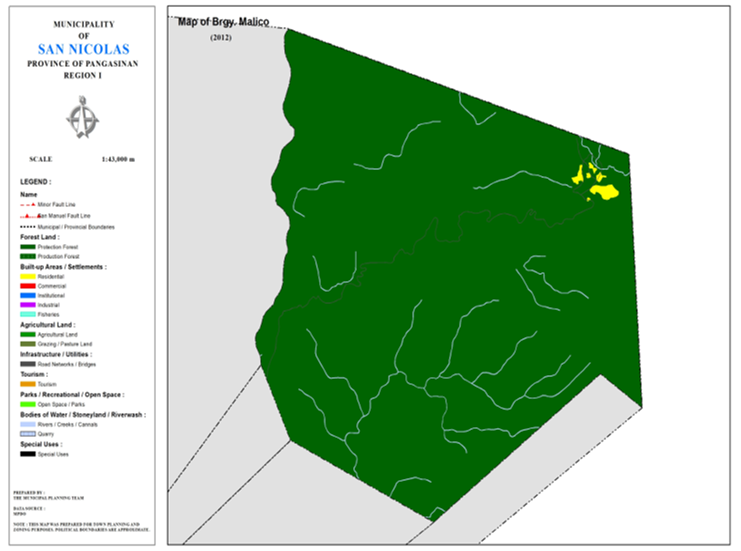BARANGAY MALICO
BRIEF SOCIO-ECONOMIC PROFILE
Is the farthest and remotest
barangay of the municipality being 40 kms. Away from the town proper and
adjoining our provincial boundary with the province of Nueva Viscaya. In fact,
it is nearer to Imugan, Nueva Viscaya being only 13 kms. Away. It is bounded on
the north by Kayapa,Nueva Viscaya; on the south by Brgy. Cacabugaoan; on the
east, by Imugan, Nueva Viscaya; on the west by Brgy. Sta. Maria East and
Fianza.
It has an approximate land erea of 710 hectares with pasture lands
covering the biggest area of land,
followed by cogan land. The irrigated land is the third biggest erea, while
corn land follows. The residential land covers the least land erea
classification. Mlaico produces mountain crops like sweet potato, gabi and
vegetables such as cabbage, sayote, Baguio beans, petchay and carrots. The high
elevation, cold climate and the fertile soil makes Malico an ideal place for
vegetables production like Benguet. According to old folks,Malico derived
its name from the winding flow of the
Catabalism River which originated from Malico and winds down the mountain
connecting with the Ambayoan River in brgy. Sta. Maria East. As could be seen
from a vantage point in the barangay, you could see the zigzagging flow of the
said river or “liko-liko” and was later called Malico.
In the early 60’s, Malico is a sitio of Sta. Maria until the PACD
creation to undertake the developmental challenges and subdivisions of teh
countrysides that Malico devolved into a separate barangay, Also, trival
leadership devolved to political leadership to the barangays leaders of
Malico.Yet the tribal leaders still very much respected, revered and honored on
matters pertaining to customs, traditions and critical issues and problems
brought to them for decision and advice.
Malico is compossed mainly of the Kalanguya ethnolinguistis group,
but everyone knows the Ilocano dialect.
The customes and traditions of the Kalanguya tribe are very much practiced and
preserved by the barangay folks although majority of them were converted to
Christianity through the long years of missionary work of Pastor Dilbert Rice,
an American UCCP Pastor, Prominent families of the barangay are the Taciong,
Tindaan, Bugtong, Ancheta, Lorenzo, Guzman, Lakias and Segundo among others.
In the early 70’s, Malico could be reached easily by motor vehicles from
the town proper through the winding Villa Verde Trail some 30 kms.away. Yet,
the national government failed to maintain the trial plus the 1990 killerquake,
that resulted to massive erosions, landslides and total destruction of the
road. Presently it could be reached only through the mountain road of Imugan,
Nueva Vizcaya. Thus, going to Malico from the town proper is like going in a
journey to Cagayan Valley as you have to take the route to San Jose City, then
to Sta. Fe, Nueva Vizcaya and via the mountain roads of Imugan and to Malico. This route covers around 60
kms. half of which is unpaved mountain road, and three (3) hours trave time.
The proposed construction of the Pangasinan-Nueva Vizcaya Road will be a
big boom not only tp Malico, but also to the municipality of San Nicolas.
Malico will become the “Gateway to the Cagayan Valley.” Due to its high
elevation, good vegetation and unique cold climate, Malico could become the
summer capital of Pangasinan. The Villa Verde Trail wiil improved as a tourist
destination due to its historic value as the battleground of the US Army 32nd
(Red Arrow) Division and the Japanese Army during the World war II
At present, Barangay Malico has seven puroks (grups) namely: Lupa, Camp
4, Sitio Singi, Purok Monumento, Purok Antero Malico Centro and Salaksak.
Boundaries :
North :Province of Nueva Vizcaya South :Brgys. Sta. Maria East, Cacabugaoan
East :Province of Nueva Vizcaya West :Brgy. Fianza
Distance from Poblacion (kms.) : 23 km
Road Type : Earth Trail
Seasons :
Dry
– December to April
Wet – May to
November
Average Annual
Rainfall (mm.) 147.21
mm
Average Monthly
Temperature (Celsius) 29.15°C
Status of Land classification (has.):
|
Existing Land Uses |
Area (has.) |
|
Protection Forest |
3,982.562 |
|
Cabalisian River |
2.520 |
|
Residential |
13.713 |
|
Creeks |
17.463 |
|
Road Networks |
0.678 |
|
Total Land Area |
4,016.935 |
Major River : Cabalisian
River
Soil Type : Annam
Clay Loam
SOCIAL PROFILE
|
Social Profile |
|
|
Total Pop. (NSO 2020) |
348 |
|
Annual Growth Rate |
1.90 |
|
Pop. Density |
30 |
|
No. of Households (CBMS 2020) |
105 |
|
Ave. Household Size |
5 |
|
Sex Ratio (Male/Female) |
107:100 |
|
Public Buildings / Facilities |
|
|
Barangay Hall |
1 |
|
Elementary School |
1 |
|
High School |
|
|
Brgy. Health Station |
|
|
Brgy. Health Center |
1 |
|
OSCA Building |
|
|
Brgy. Daycare Center |
|
|
Church |
ü UCCP ü UECDFI |
|
Brgy. Cemetery |
|
ECONOMIC SECTOR
|
Economic Sector |
|
|
Agricultural Production |
vegetable, rootcrops |
|
Livestock/Poultry Production |
|
|
Existing Industries |
|
|
Tourist Attractions |
|
INFRASTRUCTURE AND UTILITIES
|
Infrastructure and Utilities |
|
|
Transportation |
weapon type truck |
|
Telecommunications |
smart |
|
Postal Communication |
|
|
Power and Electrification |
NUVELCO, kerosene, battery |
|
Water Supply and Irrigation |
|
|
Potable Water Supply |
Level I |
|
Post Harvest Facilities |
|
|
Slaughterhouse |
|
|
Market |
|
BARANGAY OFFICIALS:
|
BARANGAY OFFICIALS |
||
|
Position |
Name |
|
|
Punong Barangay |
SANDY LIGMAYO SEGUNDO |
|
|
SBM 1 |
DARLINA LORENZO WACNAG |
|
|
SBM 2 |
BENNY OMALLO SEGUNDO |
|
|
SBM 3 |
TITO QUINAMIS ANCHETA |
|
|
SBM 4 |
JEROME SEGUNDO PILYAN |
|
|
SBM 5 |
FLORENCE GUZMAN DAMASEN |
|
|
SBM 6 |
PENDO ANCHETA LENCIO |
|
|
SBM 7 |
REBECCA COSEP SEGUNDO |
|
|
SK Chairperson |
|
GEORGINA SEGUNDO ASAMI |
|
Barangay Secretary |
JULIE L. PASIGIAN |
|
|
Barangay Treasurer |
RIZALYN S. CAUAN |
|

